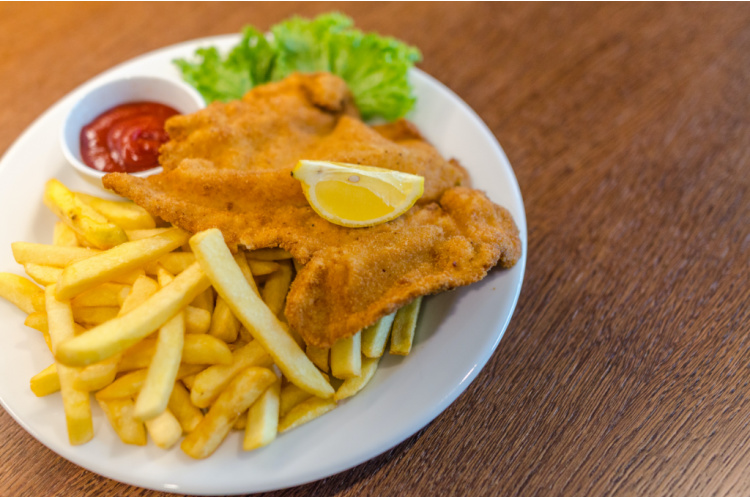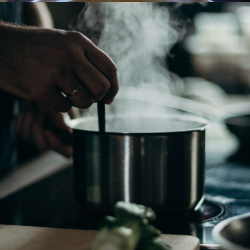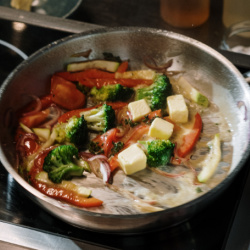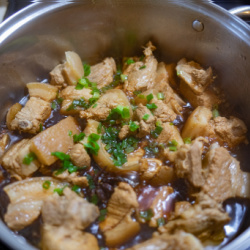The Danger of Eating Fried Food (Plus 5 Healthier Ways to Cook!)
Mar 22, 2021

Every time you eat, you’re either preventing disease, or you’re inviting it — that saying can be viewed as especially true when it comes to eating fried foods.
That’s according to a new study published in the January 2021 edition of the journal Heart, which found that fried foods are tied to a higher risk of heart disease and stroke. Researchers analyzed previously published studies that followed hundreds of thousands of participants and compared their food choices with their risk for heart disease, stroke and sometimes death. The results were alarming, showing that those who ate the most fried food had a 28% greater risk of experiencing a major cardiovascular event, as well as a 22% higher risk of heart disease and a 37% higher risk of heart failure.
And the risk gets greater the more fried food you eat — with each additional four ounces of fried foods weekly greatly increasing the chance for premature death.
Dr. Gabe Mirkin, a fitness guru, longtime radio host and sports medicine doctor with more than 50 years of practice, explored the study in a recent blog post.
“When you cook with water, the temperature cannot rise above the boiling point, and the sugars in foods combine with the water to form end products that have not been shown to be harmful,” Mirkin explained. “On the other hand, when sugars or carbohydrates (chains of sugars) are cooked with proteins or fats at high temperatures and without water, the sugars bind to the proteins and DNA to form chemicals called advanced glycation endproducts (AGEs). High-temperature cooking methods that do not use water include deep-frying.”
While it can be tempting to partake in deep fried foods (hello French fries!), there ARE other methods of cooking that don’t pose as much risk to your health.
We compiled a list of 5 alternative methods to deep-frying foods that still pack that flavor punch without the excess calories and fat from frying.
1) Steam it!

Who doesn’t like their vegetables bright, tender and fresh? Steaming is the perfect way to achieve that, particularly for delicate vegetables like carrots, brussels and asparagus. Plus, steaming keeps most of the nutrients intact and is quick and simple to do.
How to do it:
It’s easy! If you have a steamer basket, fill a medium pot with water, boil it and place the vegetables in the basket to cook until they’re tender.
If you don’t have a basket, place 3 golf-ball sized balls of aluminium foil in the water in your pot, rest a heat-proof plate on the balls, pop on your veggies, cover and steam until they’re crisp or tender.
2) Roast it!

The oven is your friend whether you’re in a hurry and don’t have time to be present while something’s cooking, or you’re just looking for an all-over, evenly cooked taste that works for pretty much any ingredient — proteins, veggies, you name it. Roasting works especially well if you’re not usually a big fan of vegetables because it brings out a naturally caramelized taste that elevates them to the next level.
How to do it:
Preheat the oven to whatever your recipe calls for. Line a baking sheet with aluminum foil for proteins (easy cleanup!) or parchment paper for veggies. Set the timer to whatever time the recipe calls for, pop it in there and voila! That’s it. Simple, right?
3) Grill it!

Grilling is a great, healthy way to prepare food. Plus, it’s one of the easier ways to do things (especially when it comes to cleanup time), and it is just the thing for a nice evening on the back patio as the weather warms up. Grilling makes for good, crisp veggies and gives meat a nice, smoky flavor.
How to do it:
Be sure to fully preheat your grill before cooking the food. Different ingredients call for different ways of grilling (whether over direct heat or a bit away from it), so be sure to check the best method for whatever you’re grilling.
4) Sauté it!

Sautéing is quick, easy and packs a ton of flavor into meats and veggies. Veggies retain their nutrients and meats retain their juices, making for a fast way to whip up a delicious, home-cooked meal.
How to do it:
Heat a non-stick pan on the oven burner. Place a bit of liquid in the pan (olive oil, water or broth). Add your chicken or veggies and heat them through for as long as the recipe calls for. That’s it!
5) Braise/stew it!

What’s better than a slow-cooked veggie or meat on a cool night? That’s exactly what you’ll get by braising or stewing your dish, which works best with heartier vegetables or starches like potatoes or squash, or with meats like pot roast or pork shoulders.
How to do it:
If you have a crockpot, that is one of the best ways to slow cook your meal. Follow the recipe, but the gist of it is placing the protein in water, broth or even wine and letting it cook for 6-8 hours. This is an especially great method if you’re able to start something early in the day so it’s ready to roll by dinner time (without you having to do anything else!).
What’s your favorite cooking method? Share in the comments below!
------------------------------------------------------------------------------------
Author: Caitlin H
Diet-to-Go Community Manager
Caitlin is the Diet-to-Go community manager and an avid runner. She is passionate about engaging with others online and maintaining a healthy, active lifestyle. She believes moderation is key, and people will have the most weight loss success if they engage in common-sense healthy eating and fitness.










